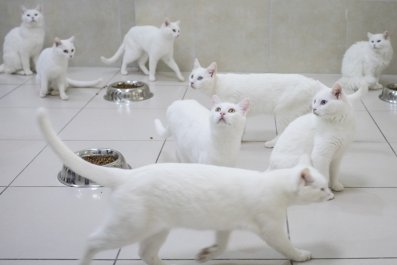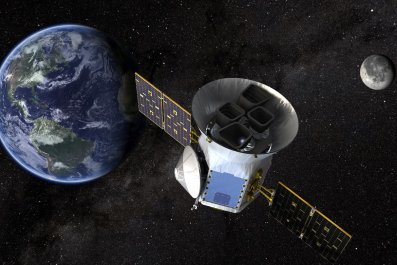NASA's next planet-hunting telescope, called the Transiting Exoplanet Survey Satellite—or TESS—is expected to launch April 16, in hopes of identifying more than 1,000 exoplanets for scientists to study. But it turns out that a lack of research much closer to home may make it harder for scientists to act on the data TESS sends home.
Exoplanet scientists are particularly interested in planets about the size of Earth because they are the most tantalizing candidates for hiding extraterrestrial life. In our solar system, Venus is the only planet that can compare with our own in terms of size and distance from the sun. Nevertheless, we know shockingly little about our neighbor and near twin, except for the fact that it's nothing like Earth.
As a result, some exoplanet scientists have called for new missions dedicated to Venus, arguing that they need more information about our neighbor before they can do their best science about distant worlds.
"This is definitely a theme that is coming up in the literature recently," Laura Schaefer, a planetary scientist at Arizona State University who in 2016 used models based on Venus to make hypotheses about a new exoplanet called GJ 1132B, told Newsweek. "[Venus] is probably the best analog for most of the planets that we're going to be able to characterize well in the future."
That's because TESS identifies exoplanets as they pass between Earth and their sun, causing a tiny dip in the star's brightness. With this technique, it becomes harder to spot any given planet the farther away from its star it is. That means scientists will identify more planets closer to their stars—more Venus analogs than Earth analogs.
Venus has always been a puzzle because it's about the same size as Earth, only a little closer to the sun and presumably formed from the same basic mix of ingredients. But while Earth is generally pleasant, Venus is a hellishly hot planet drowning in an atmosphere full of carbon dioxide. Scientists aren't quite sure what went wrong for Venus and right for Earth.
"Venus is widely regarded as the most hostile environment in our entire solar system," Stephen Kane, an exoplanet scientist at the University of California, Riverside, told Newsweek. "It's just completely bizarre that we should have two planets the same size but opposite ends of the habitability spectrum."
And that leads to a bigger problem: Without a thorough understanding of Venus, scientists' models of what could be happening inside distant planets are based on just Earth. Incorporating more information about Venus would double the number of scenarios those models would need to explain, making them much more robust.
"Without [a new mission], we're still going to be stuck with big gaps in our understanding," Paul Byrne, a planetary geologist at North Carolina State University who has done work on Venus, told Newsweek.
Rather than try to fill in those gaps, NASA and planetary scientists have tended to focus on Mars, since that's our best bet for finding evidence of previous life. "The Venus community looks with great envy upon their Martian colleagues," Kane said. "The folks who are studying Mars, they have all kinds of missions and rovers and money thrown at them from the perspective of the Venus community."
Related: Venus is more like Earth than we thought despite nightmare atmosphere
Byrne said that may be the result of momentum more than of solid reasoning. In the late '90s, Mars became the hot target, and the science community settled into a steady rhythm of new missions to the red planet, while Venus fell into the shadows—when the occasional mission does visit, it rarely has the power to peer below the planet's thick clouds. Venus's deadly atmosphere eliminates any possibility of a rover and leaves a lander's expected lifespan at mere hours. (Lucky Martian robots can clock more than a decade on the job.)
But Byrne says that given modern technology, it's worth giving Venus another shot. "The narrative has taken over that Venus is hard," he said. "There's no law of physics that needs to be bent or broken to operate this technology."
In the meantime, the gaps remain and scientists worry that they're missing key information about how planets work. "I absolutely think that the only way we can test our models is if we can benchmark them against real data," Schaefer said. And the only source of new data we can really reach is Venus.
One of the biggest Venusian mysteries scientists want to tackle is its atmosphere, which is mostly carbon dioxide. Scientists think that as the planet became ever hotter, it should have produced a lot of oxygen as water evaporated, but they've also realized that oxygen would have trouble escaping out into space.
That means they want to figure out where it went—one theory holds it may have been absorbed by the planet's crust. But until a mission gets below Venus's atmosphere, they can't be sure. Better understanding where oxygen goes will be key to recognizing whether any oxygen detected in an exoplanet's atmosphere was put there by living things, as on Earth.
Learning more about our sister planet may have another benefit. The sun is always slowly expanding, which means that Venus likely once received about the same amount of solar energy as Earth does now—and that one day we may face an onslaught much like Venus's.
"If you wind the tape way back, it's possible Venus may even have been Earthlike," Byrne said. "The bottom line is Venus may show us what Earth's future fate may be."


















